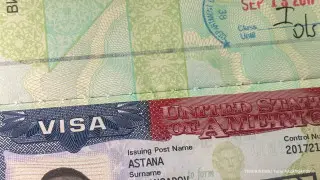Tengrinews.kz - Kazakhstanis are being denied more often for US visas.
According to published data from the US Department of State, the refusal rate for non-immigrant B1/B2 visas (tourist and business) for Kazakhstani citizens in 2024 was 46.29%. The value has increased significantly compared to 41.93% in 2023 and in 2022 and 2021, when the rates were 44.02% and 43.29%, respectively. In 2020, the refusal rate was 47.34%.
Reports show that US consulates in Kazakhstan issued 22,526 B1/B2 visas in 2023. The Almaty Consulate issued 2589 visas, while the Astana Consulate processed 23 161 applications.
The total number of non-immigrant visas of different categories issued in 2023 in Kazakhstan is as follows:
- A1 (diplomatic visas) – 24;
- A2 (diplomatic visas) – 244;
- B1 (business visas) – 26;
- B1/B2 (tourist and business visas) – 22,526;
- B2 (tourist visas) – 14;
- C1 (transit visas) – 93;
- C1/D (visas for crew members) – 1.
By comparison, the statistics for 2022, which was heavily impacted by the COVID-19 pandemic and the suspension of visa applications, look different. Significantly fewer visas were issued in 2022, and the data by category is slightly different.
- A (diplomatic visas) – 223;
- B1 (business visas) – 20;
- B2 (tourist visas) – 1;
- B-1,2 (business and tourist visas) – 14 385;
- C (transit visas) – 81;
- D (visas for aircraft and ship crew members) – 196;
- E (investor visas) – 98;
- F (student visas) – 1,644;
- G (official visas for international organizations) – 239;
- H (work visas) – 121;
- I (visas for media representatives) – 32;
- J (educational and cultural exchanges) – 3240.
Note that data for 2024 has not yet been published.
How does the situation compare to other Central Asian countries
Among the Central Asian countries, citizens of Kazakhstan were rejected less than citizens of Uzbekistan (64.41%) and Turkmenistan (58.80%), but more than applicants from Tajikistan (45.24%) and Kyrgyzstan (39.14%).
World statistics
The highest percentages of rejections in 2024 were recorded for citizens of countries such as Laos (82.84%), Somalia (77.02%), and Liberia (79.38%).
At the same time, some countries demonstrate minimal rejection rates: for example, residents of Brunei faced rejections in only 4% of cases, and citizens of countries such as Liechtenstein and the Vatican did not receive a single rejection at all.
How the refusal rate is calculated
It is important to understand how the adjusted refusal rate is calculated. It takes into account not only the number of refusals but also the number of visas issued, as well as cases where applicants were able to provide additional information and obtain a review of the refusal decision. A detailed explanation of the calculation method is available on the US Department of State website.
Obtaining a US visa is a complex process, and a consular officer's decision depends on many factors. Each case is considered individually, and a visa refusal does not always mean that the applicant will never be able to obtain a visa in the future. Applicants are advised to thoroughly prepare for the interview, gather all necessary documents, and provide as complete and accurate information as possible about their travel plans.
Earlier, it was reported how many Kazakhstanis were arrested and deported from the US.
In addition, Deputy Minister of Foreign Affairs Alibek Bakayev commented on the information about the deportation of Kazakhs from the United States.

